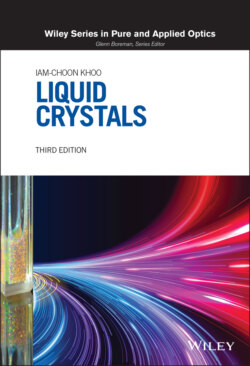Читать книгу Liquid Crystals - Iam-Choon Khoo - Страница 11
1.1. MOLECULAR STRUCTURES AND CHEMICAL COMPOSITIONS
ОглавлениеWith few exceptions, liquid crystals are composed of organic substances with a typical structure, as depicted in Figure 1.1. They are aromatic and, if they contain benzene rings, they are often referred to as benzene derivatives. In general, aromatic liquid crystal molecules such as those shown in Figure 1.1 comprise a side chain R, two or more aromatic rings A and A′, connected by linkage groups X and Y, and at the other end connected to a terminal group R′.
Examples of side chain and terminal groups are alkyl (CnH2n+1), alkoxy (CnH2n+1O), and others such as acyloxyl, alkyl carbonate, alkoxy carbonyl, and the nitro and cyano groups. The Xs of the linkage groups are simple bonds or groups such as stilbene (— —), ester (— —), tolane (——), azoxy (——), Schiff base (— —), acetylene ( — —), and diacetylene (—). The names of liquid crystals are often fashioned after the linkage group (e.g. Schiff‐base liquid crystal). There are quite a number of aromatic rings. These include saturated cyclohexane or unsaturated phenyl, biphenyl, and terphenyl in various combinations.
The majority of liquid crystals are benzene derivatives; the rest include heterocyclics, organometallics, sterols, and some organic salts or fatty acids. Their typical structures are shown in Figures 1.2–1.4. Heterocyclic liquid crystals are similar in structure to benzene derivatives, with one or more of the benzene rings replaced by a pyridine, pyrimidine, or another similar group. Cholesterol derivatives are the most common chemical compounds that exhibit the cholesteric (or chiral nematic) phase of liquid crystals. Organometallic compounds are special in that they contain metallic atoms and possess interesting dynamical and magneto‐optical properties.
Figure 1.1. Molecular structure of a typical liquid crystal.
Figure 1.2. Molecular structure of a heterocyclic liquid crystal.
Figure 1.3. Molecular structure of an organometallic liquid crystal.
Figure 1.4. Molecular structure of a sterol.
All the physical and optical properties of liquid crystals such as dielectric constants, elastic constants, viscosities, absorption spectra, transition temperatures, the existence of mesophases, anisotropies, and optical nonlinearities are governed by the properties of these constituent groups and how they are chemically synthesized together. Since these molecules are quite large and anisotropic, and therefore very complex, it would take a treatise to discuss all the possible variations in the molecular architecture and the resulting changes in their physical properties. Nevertheless, there are some general observations one can make on the dependence of the physical properties on the molecular constituents [2]. For example, the chemical stability of liquid crystals depends very much on the central linkage group. Schiff‐base liquid crystals are usually quite unstable. Ester, azo, and azoxy compounds are more stable but are also quite susceptible to moisture, temperature change, and ultraviolet (UV) radiation. Compounds without a central linkage group are among the most stable liquid crystals ever synthesized. The most widely studied one is 5CB (pentyl cyanobiphenyl), whose structure is shown in Figure 1.5. Other compounds such as pyrimide and phenyl cyclohexane are also quite stable.
Figure 1.5. Molecular structure of 5CB (pentyl cyanobiphenyl).
